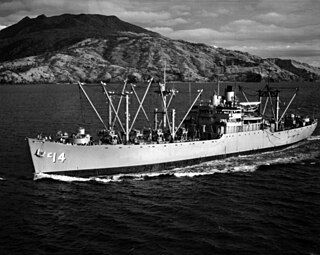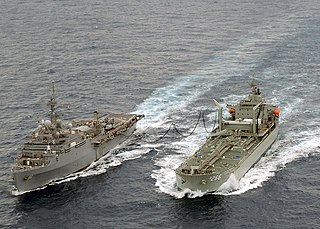Development
As part of the auxiliary ship program of 1959, drafts for the construction of Type 706 ammunition transporters were drawn up in 1963/64. At the end of 1964, the Orenstein & Koppel shipyard in Lübeck received the order to build two Type 706 ships.
In the mid-1980s, the two ammunition transporters received the complete package for maneuvering, consisting of a transverse thrust system, Becker rudder and GUY reduction gear. The supply stations on the Westerwald were subsequently enlarged, and external platforms that could be folded out to the side were installed. [1]
Armaments were only available during the time with a military crew on board. [2]
The Odenwald was mainly used for the transport of MM-38 missiles to and from Brest / France. The Westerwald was used as a supplier in addition to transporting ammunition. In many cases, he was deployed as a supplier in speedboat or minesweeping squadrons when the tender subordinate to the squadrons was not available.
The two ships were officially reclassified as utilities in the 1990s. The Westerwald received Type 760A and the Odenwald received Type 760B.

The German Navy is the navy of Germany and part of the unified Bundeswehr, the German Armed Forces. The German Navy was originally known as the Bundesmarine from 1956 to 1995, when Deutsche Marine became the official name with respect to the 1990 incorporation of the East German Volksmarine. It is deeply integrated into the NATO alliance. Its primary mission is protection of Germany's territorial waters and maritime infrastructure as well as sea lines of communication. Apart from this, the German Navy participates in peacekeeping operations, and renders humanitarian assistance and disaster relief. They also participate in anti-piracy operations.

USS Thetis Bay (CVE-90) was the thirty-sixth of fifty Casablanca-class escort carriers built for the United States Navy during World War II. She was launched in March 1944, commissioned in April, and served as a transport carrier in the Pacific, as well as a replenishment carrier supporting the Allied bombardment of Tokyo and the Main Islands. Postwar, she participated in Operation Magic Carpet, before being decommissioned in August 1946, being mothballed in the Pacific Reserve Fleet. She was reactivated in July 1956, and converted to a helicopter transport carrier, serving in relief operations in Taiwan and Haiti. Ultimately, she was broken up in 1966, the last Casablanca-class hull to be scrapped.

USS Windham Bay (CVE-92) was the thirty-eighth of fifty Casablanca-class escort carriers built for the United States Navy during World War II. She was named after Windham Bay, within Tongass National Forest, of the Territory of Alaska. The ship was launched in March 1944, commissioned in May, and served as a replenishment and transport carrier throughout the Invasion of Iwo Jima and the Battle of Okinawa. Postwar, she participated in Operation Magic Carpet, repatriating U.S. servicemen from throughout the Pacific. She was decommissioned in August 1946, when she was mothballed in the Pacific Reserve Fleet. With the outbreak of the Korean War, however, she was called back to service, continuing to serve as a transport and utility carrier until 1959, when she was once again decommissioned. Ultimately, she was broken up in February 1961.

Combat stores ships, or storeships, were originally a designation given to ships in the Age of Sail and immediately afterward that navies used to stow supplies and other goods for naval purposes. Today, the United States Navy and the Royal Navy operate modern combat store ships. The Sirius and Mars classes and the Fort Rosalie and Fort Victoria classes provide supplies, including frozen, chilled and dry provisions, and propulsion and aviation fuel to combatant ships that are at sea for extended periods of time. Storeships should not be confused with fast combat support ships or tenders.

USS Firedrake (AE-14) was a Mount Hood-class ammunition ship in service with the United States Navy from 1944 to 1946 and from 1951 to 1971. She was scrapped in 1978.

A replenishment oiler or replenishment tanker is a naval auxiliary ship with fuel tanks and dry cargo holds which can supply both fuel and dry stores during underway replenishment (UNREP) at sea. Many countries have used replenishment oilers.

Replenishment at sea (RAS) or underway replenishment (UNREP) is a method of transferring fuel, munitions, and stores from one ship to another while under way. First developed in the early 20th century it was used extensively by the United States Navy as a logistics support technique in the Pacific theatre of World War II, permitting U.S. carrier task forces to remain at sea indefinitely.

An auxiliary ship is a naval ship designed to support combatant ships and other naval operations. Auxiliary ships are not primary combatant vessels, though they may have some limited combat capacity, usually for purposes of self-defense.

The Cimarron-class oilers were an underway replenishment class of oil tankers which were first built in 1939 as "National Defense Tankers," United States Maritime Commission Type T3-S2-A1, designed "to conform to the approved characteristics for naval auxiliaries in speed, radius and structural strength", anticipating their militarization in the event of war. "Tentative plans had been reached with the Standard Oil Company of New Jersey to build ten high-speed tankers with the government paying the cost of the larger engines needed for increased speed. By the first week in December [1937], Standard Oil had solicited and received bids from a number of yards providing for the construction of a number of 16,300-ton (deadweight) capacity tankers. Bids were requested for two versions: a single-screw design of 13 knots and a twin-screw design of 18 knots. The price difference between the two would be used to establish the government's cost subsidy for greater speed. Plans and specifications for both designs were prepared for Standard Oil by naval architect E. L. Stewart. It seems certain that the design for the 18-knot tanker evolved out of the bureau's (C&R) design for a fleet oiler."

An ammunition ship is an auxiliary ship specially configured to carry ammunition, usually for naval ships and aircraft. An ammunition ship's cargo handling systems, designed with extreme safety in mind, include ammunition hoists with airlocks between decks, and mechanisms for flooding entire compartments with sea water in case of emergencies. Ammunition ships most often deliver their cargo to other ships using underway replenishment, using both connected replenishment and vertical replenishment. To a lesser extent, they transport ammunition from one shore-based weapons station to another.

The 3"/50 caliber gun in United States naval gun terminology indicates the gun fired a projectile 3 inches (76 mm) in diameter, and the barrel was 50 calibers long. Different guns of this caliber were used by the U.S. Navy and U.S. Coast Guard from 1890 through the 1990s on a variety of combatant and transport ship classes.

The Type 908 replenishment ship is a class of multi-product replenishment oilers commissioned into the People's Liberation Army Navy and the Royal Thai Navy. The first Type 908 replenishment ship, Qinghaihu, was originally laid down for the Soviet Navy as a Komandarn Fedko-class merchant tanker, but construction was halted due to insufficient funds. The ship was then purchased by China as an incomplete vessel in 1993 from post-Soviet Ukraine. The ship has a near sister ship (INS Jyoti) operating with the Indian Navy. After significant refit, the ship was consecutively renamed Qinghaihu (885), formerly ex Nancang and ex-Vladimir Peregudov. Another similar ship was built and sold to Thailand and currently in service with the Royal Thai Navy as HTMS Similan (871).

The Type 905 auxiliary oiler replenishment is a class of auxiliary oiler replenishment (AOR) vessels used by the People's Liberation Army Navy and Pakistan Navy to resupply ships at sea with food, munitions, fuel and spare parts. One ship is now a commercial oil tanker in China. It is also known as Taicang class.
400-ton class ammunition ship is a class of naval auxiliary ship currently in service with the People's Liberation Army Navy (PLAN). The exact type of this class remain unknown as of 2015, because no official information has been released, despite the ships have already been in service around a decade. 400-ton class is the most commonly referred term when describe these ships 400-ton class ammo ship in PLAN service is designated by a combination of an alphabet followed by three-digit number. The alphabet is Y, the abbreviation of Yun, which is for the Chinese character (运), meaning transport. However, the pennant number may have changed due to the change of Chinese naval ships naming convention.

The Etna class is a ship class of two naval replenishment and logistic support ships used by the Italian Navy and by the Greek Navy The two ships are almost identical but they have differences in their armament and sensor equipment.

Rhein (A513) is the third ship of the Elbe-class replenishment ships of the German Navy.

The Type 701Lüneburg-classreplenishment ship was a class of eight replenishment ships of the German Navy. Each ship in the class bore the name of a German city that ended in -burg.
















